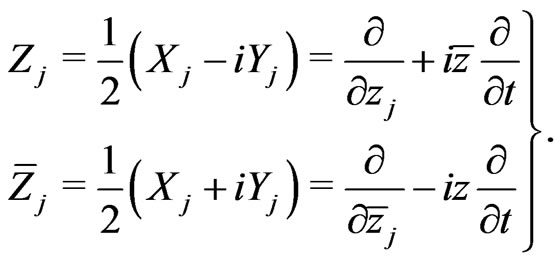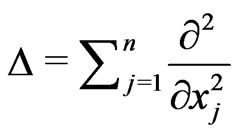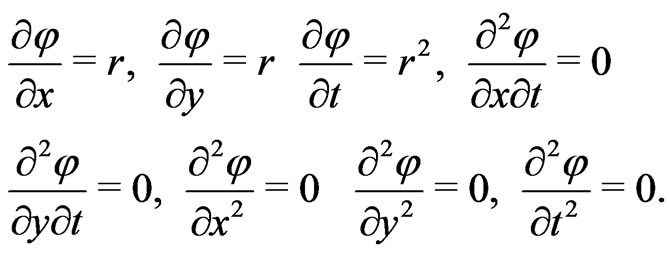Advances in Pure Mathematics
Vol.2 No.5(2012), Article ID:22807,4 pages DOI:10.4236/apm.2012.25051
On Some Properties of the Heisenberg Laplacian
Department of Mathematics, Universty of Ibadan, Ibadan, Nigeria
Email: murphy.egwe@mail.ui.edu.ng, me_egwe@yahoo.co.uk
Received May 11, 2012; revised June 18, 2012; accepted June 24, 2012
Keywords: Heisenberg group; Heisenberg Laplacian; Factorization; Universal enveloping algebra; solvability
ABSTRACT
Let  be the
be the  -dimensional Heisenberg group and let
-dimensional Heisenberg group and let  and
and  be the sublaplacian and central element of the Lie algebra of
be the sublaplacian and central element of the Lie algebra of  respectively. For
respectively. For  denote by
denote by  the Heisenberg Laplacian and let
the Heisenberg Laplacian and let  be a compact subgroup of Automorphism of
be a compact subgroup of Automorphism of . In this paper, we give some properties of the Heisenberg Laplacian and prove that
. In this paper, we give some properties of the Heisenberg Laplacian and prove that  and
and  generate the
generate the  -invariant universal enveloping algebra,
-invariant universal enveloping algebra,  of
of .
.
1. Preliminaries
The Heisenberg group (of order ),
),  is a noncommutative nilpotent Lie group whose underlying manifold is
is a noncommutative nilpotent Lie group whose underlying manifold is  with coordinates
with coordinates  and group law given by
and group law given by

Setting , then
, then  forms a real coordinate system for
forms a real coordinate system for . In this coordinate system, we define the following vector fields:
. In this coordinate system, we define the following vector fields:

It is clear from [1] that  is a basis for the left invariant vector fields on
is a basis for the left invariant vector fields on  These vector fields span the Lie algebra
These vector fields span the Lie algebra  of
of  and the following commutation relations hold:
and the following commutation relations hold:

Similarly, we obtain the complex vector fields by setting
 (1)
(1)
In the complex coordinate, we also have the commutation relations

The Haar measure on  is the Lebesgue measure
is the Lebesgue measure  on
on  [2]. In particular, for
[2]. In particular, for , we obtain the 3-dimensional Heisenberg group
, we obtain the 3-dimensional Heisenberg group  (since
(since ). Hence
). Hence  may also be referred to as (2n + 1)-dimensional Heisenberg group.
may also be referred to as (2n + 1)-dimensional Heisenberg group.
One significant structure that accompanies the Heisenberg group is the family of dilations

This family is an automorphism of . Now, if
. Now, if  is an automorphism, there exists an induced automorphism,
is an automorphism, there exists an induced automorphism,  such that
such that

For simplicity, assume that  and
and  coincide. Thus we may simply assume that if
coincide. Thus we may simply assume that if  we have
we have 
2. Heisenberg Laplacian
An operator that occurs as an analogue (for the Heisenberg group) of the Laplacian
 on
on  is denoted by
is denoted by  where
where 
is a parameter and defined by

where  are as defined in (1) so that
are as defined in (1) so that  can be written as
can be written as
 (2)
(2)
 is called the sublaplacian.
is called the sublaplacian.  satisfies symmetry properties analogous to those of
satisfies symmetry properties analogous to those of  on
on . Indeed, we have that
. Indeed, we have that 
1) is left-invariant on ;
;
2) has degree 2 with respect to the dilation automorphism of  and 3) is invariant under unitary rotations.
and 3) is invariant under unitary rotations.
Several methods for the determination of solutions, fundamental solutions of (2) and conditions for local solvability are well known [3-5].
The Heisenberg-Laplacian is a subelliptic differential operator defined for  as
as  on
on  and denoted by
and denoted by . It is obtained from the usual vector fields as
. It is obtained from the usual vector fields as
 (3)
(3)
By a technique in [6], the operator  is factorized into two quasi-linear first order operators on
is factorized into two quasi-linear first order operators on  as:
as:

and

so that

Introducing the Lie algebra structure, we have

indicating that the Heisenberg algebra is noncommutative and  is hypoelliptic [4]. We thus obtain an operator (which is a homogeneous element of
is hypoelliptic [4]. We thus obtain an operator (which is a homogeneous element of , the universal enveloping algebra of the Heisenberg group when
, the universal enveloping algebra of the Heisenberg group when  is the Heisenberg algebra) [5] consistent with that of Hans Lewy [7]. In [2], it has been shown that none of the factors of
is the Heisenberg algebra) [5] consistent with that of Hans Lewy [7]. In [2], it has been shown that none of the factors of ,
,  or
or  is solvable and as such,
is solvable and as such,  is not solvable.
is not solvable.
In this paper, we shall prove that  only possesses a trivial group-invariant solution and for
only possesses a trivial group-invariant solution and for  a compact subgroup of
a compact subgroup of  we have that
we have that
 the K-invariant universal enveloping algebra of the Heisenberg group is generated by
the K-invariant universal enveloping algebra of the Heisenberg group is generated by  and
and .
.
Now, by a solution of a factor  say, we shall mean that if
say, we shall mean that if  are independent real variables, and
are independent real variables, and  such that
such that  has a solution
has a solution  in the neighbourhood
in the neighbourhood  of the point
of the point , with
, with  then
then  is analytic at
is analytic at .
.
Definition 2.0. Let  be any open subset of
be any open subset of , and
, and  a number such that
a number such that  A function
A function  on
on  satisfying
satisfying

is said to be uniformly Holder continuous with Holder exponent  if
if  when
when  they are called uniformly Lipschitz continuous. When
they are called uniformly Lipschitz continuous. When  they are simply continuous and bounded. A function is said to be in
they are simply continuous and bounded. A function is said to be in  -space if its first partial derivatives satisfy a Holder condition with positive exponent, provided the distance of the points involved does not exceed 1.
-space if its first partial derivatives satisfy a Holder condition with positive exponent, provided the distance of the points involved does not exceed 1.
Theorem 2.1. Let  be a periodic real
be a periodic real  -function which is analytic in no t-interval. Then there exists a
-function which is analytic in no t-interval. Then there exists a  -function
-function  determined by the derivative
determined by the derivative  of
of  such that
such that

has no  -solution,(no matter what open
-solution,(no matter what open  -set taken as domain of existence).
-set taken as domain of existence).
For Proof, see [8].
Theorem 2.2. The Heisenberg Laplacian,  defined in (3) has no non-trivial group invariant solution.
defined in (3) has no non-trivial group invariant solution.
Proof. Let  be a group-invariant solution of (3). We wish to show that
be a group-invariant solution of (3). We wish to show that  To do this, let
To do this, let  be a map generated by the group of automorphisms, dilations
be a map generated by the group of automorphisms, dilations  where
where  determines the growth or decay rate. If
determines the growth or decay rate. If  is defined by
is defined by

then obtaining the first and second order derivatives of  with respect to the independent variables we have
with respect to the independent variables we have

Substituting these into (3), we obtain a trivial equation. But by Group-invariant method, we should obtain a system of ordinary differential equations of lower order (see [9] p. 185). Thus, there exists no non-trivial groupinvariant solution for . □
. □
Theorem 2.3. Let  be a compact subgroup of
be a compact subgroup of , then
, then  the
the  -invariant universal enveloping algebra of the Heisenberg group is generated by
-invariant universal enveloping algebra of the Heisenberg group is generated by  and
and .
.
Proof. Let  be the algebra of
be the algebra of  -invariant differential operators on
-invariant differential operators on  and let
and let  be the symmetric algebra generated by the set
be the symmetric algebra generated by the set

We note that the derived action of  on
on  is given by
is given by

and  acts on
acts on  via
via

and on  the
the  -valued polynimial functions on
-valued polynimial functions on  -vector space
-vector space  via
via

Now, if we identify  with the complexified symmetric algebra
with the complexified symmetric algebra  then the symmetric product
then the symmetric product  of
of  becomes the polynomial
becomes the polynomial  given by
given by

Now, define a symmetrization map by

with

Now since  acts on
acts on  and
and  by automorphism and
by automorphism and  defined by
defined by

induces an algebra map on the associated graded algebras and by induction [10, p. 282] the eigenfunctions of 
and  are eigenfunctions of any element in
are eigenfunctions of any element in 
we have that the following diagram is commutative.

for  Since
Since  is a linear isomorphismit maps
is a linear isomorphismit maps  onto
onto  Since the action of
Since the action of
 preserves degree on
preserves degree on , and by [11], if
, and by [11], if
 generates
generates  then,
then,
 generates
generates  If
If  then
then

where the sum is finite and each  is a polynomial which is
is a polynomial which is  -invariant. Thus, the result follows by the fact that the eigenfunctions of
-invariant. Thus, the result follows by the fact that the eigenfunctions of  and
and  are the eigenfunctions of
are the eigenfunctions of  [12]. □
[12]. □
REFERENCES
- G. B. Folland and E. M. Stein, “Estimate for the Complex and Analysis on the Heisenberg Group,” Communications on Pure and Applied Mathematics, Vol. 27, No. 4, 1974, pp. 429-522. doi:10.1002/cpa.3160270403
- R. Howe, “On the Role of the Heisenberg Group in Harmonic Analysis,” Bulletin of the American Mathematical Society, Vol. 3, No. 2, 1980, pp. 821-843. doi:10.1090/S0273-0979-1980-14825-9
- E. M. Stein, “Harmonic Analysis: Real Variable Methods, Orthogonality and Oscillatory Integrals,” Princeton University Press, Princeton, 1993.
- G. B. Folland, “A Fundamental Solution for a Subelliptic Operator,” Bulletin of the American Mathematical Society, Vol. 79, No. 2, 1973, pp. 373-376. doi:10.1090/S0002-9904-1973-13171-4
- L. P. Rothschild, “Local Solvability of Left-Invariant Differential Operators on the Heisenberg Group,” Proceedings of the American Mathematical Society, Vol. 74, No. 2, 1979, pp. 383-388. doi:10.1090/S0002-9939-1979-0524323-X
- M. E. Egwe, “Aspects of Harmonic Analysis on the Heisenberg Group,” Ph.D. Thesis, University of Ibadan, Ibadan, 2010.
- H. Lewy, “An Example of a Smooth Linear Partial Differential Operator without Solution,” Annals of Mathematics, Vol. 66, No. 2, 1957, pp. 155-158. doi:10.2307/1970121
- U. N. Bassey and M. E. Egwe, “Non-Solvability of Heisenberg Laplacian by Factorization,” Journal of Mathematical Sciences, Vol. 21, No. 1, 2010, pp. 11-15.
- P. J. Olver, “Application of Lie Groups to Differential Equations,” Graduate Texts in Mathematics, SpringerVerlag, Berlin, 1986.
- S. Helgason, “Groups and Geometric Analysis: Integral Geometry, Differential Operators and Spherical Functions,” Academic Press Inc., New York, 1984.
- V. S. Varadarajan, “Lie Groups, Lie Algebras and Their Representations,” Springer-Verlag, Berlin, 1984.
- R. Strichartz, “Harmonic Analysis and Radon Transforms on the Heisenberg Group,” Journal of Functional Analysis, Vol. 96, No. 2, 1991, pp. 350-406. doi:10.1016/0022-1236(91)90066-E

